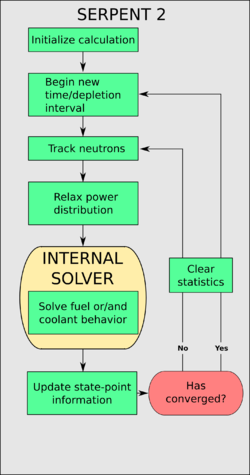Difference between revisions of "FINIX fuel behavior module"
(→Obtaining FINIX) |
(→Linking FINIX input files) |
||
| Line 46: | Line 46: | ||
=== Linking FINIX input files === | === Linking FINIX input files === | ||
| + | |||
| + | The FINIX fuel behavior solver has three different input-file types (see Section 7.6 in the FINIX manual<ref>Ikonen T., Kättö J. and Loukusa H. "''FINIX - Fuel behavior model and interface for multiphysics applications - Code documentation for version 0.15.6''", Research report, VTT-R-02988-15 (2015)</ref> | ||
=== Creating power binning to be used with FINIX solvers === | === Creating power binning to be used with FINIX solvers === | ||
Revision as of 12:53, 27 November 2015
Contents
About FINIX
FINIX is a novel light-weight fuel behavior code designed specifically for coupled calculations by T. Ikonen at VTT[1]. FINIX solves both the temperature distribution in the fuel rod and the heat flux from cladding to coolant allowing two-way couplings with both neutronics and thermal-hydraulics solvers. While the current capabilities of FINIX are specifically directed to calculating the fuel rods' thermal response in fast transient scenarios, FINIX can also be used to calculate steady state conditions.
The correlations used in FINIX are publicly available. The fuel rod is modeled in FINIX as consisting of separate axial zones that are coupled via the gas gap pressure. The thermal and mechanical models in each of the axial zones are coupled via the gas gap pressure and heat conductance.
FINIX uses the so-called 1.5 dimensional geometry model dividing the active length of the fuel rod into multiple axial zones. In each axial zone the fuel pellet and the cladding are divided into multiple concentric radial rings. The axial coupling between the different zones comes from the coolant temperature boundary condition and rod internal pressure.
Coupling with Serpent
FINIX is coupled with Serpent 2 at the source code level. The internal coupling works with direct memory access between Serpent and FINIX simplifying the solution transfer and use.
Obtaining FINIX
FINIX can be licensed from VTT for research & education (non-commercial) purposes. One license agreement per organization is enough. ...
Finally, contact Ville Valtavirta to obtain the latest version of FINIX to add to your Serpent source code.
Compiling Serpent with FINIX
The source code for FINIX should be located in the Serpent source code folder in a subfolder called FINIX.
<sss_source_code_folder>/FINIX/
To complile Serpent with FINIX, uncomment two lines from the Makefile:
... # Compilation with FINIX: #OBJS += $(FOBJS) #CFLAGS += -DFINIX ...
is uncommented to
... # Compilation with FINIX: OBJS += $(FOBJS) CFLAGS += -DFINIX ...
Running the make-command for the uncommented Makefile will compile Serpent with FINIX-capabilities. Any errors encountered in the compilation process should be reported to Ville Valtavirta.
Usage
Linking FINIX input files
The FINIX fuel behavior solver has three different input-file types (see Section 7.6 in the FINIX manual[2]
Creating power binning to be used with FINIX solvers
The detail of the power-distribution tallied by Serpent and relayed to the FINIX solvers has to be set up before the simulation. The "finbin" input-card can be used to set up the power binning for the FINIX fuel rods:
finbin <name> <rmin> <rmax> <nr> <zmin> <zmax> <n>
Input values:
| <rmin> | : minimum radial coordinate (cm) |
| <rmax> | : maximum radial coordinate (cm) |
| <nr> | : number of radial zones |
| <zmin> | : minimum axial coordinate (cm) |
| <zmax> | : maximum axial coordinate (cm) |
| <nz> | : number of axial zones |
The radial division is equal area. The axial division should be the same as in the FINIX rod options.
Creating FINIX solvers for Serpent pins
Modifying material TMS temperature limits
Linking Serpent pins with FINIX solvers sets on the on-the-fly TMS temperature treatment for the cross section data. The TMS method uses estimates for minimum and maximum temperatures of the materials it handles to increase the performance of the rejection sampling it uses. When a static multi-physics interface is linked to the main input the TMS limits are set to the minimum and maximum temperatures found in the interface, but in a typical coupled multi-physics calculation, the minimum and maximum temperature of each material is not known beforehand. In this case, the TMS limits must be set before the beginning of the calculation by using the "tft" switch in the material card:
mat <name> <density> tft <Tmin> <Tmax> [...]
Setting a tighter temperature interval for the material increases the sampling efficiency in the TMS-routines. The tradeoff is that, in case the material temperatures go beyond the preset interval the simulation is terminated (as the sampling would become unphysical). One should thus set wide enough a temperature interval to cover the whole temperature interval that is expected to be present in the material. One should also take in account that due to the stochastic nature of Monte Carlo simulations the power distribution during individual iterations will contain statistical variations leading to increased power production in some rods and reduced power production in others.
Setting up the iteration scheme
References
- ^ T. Ikonen, V. Tulkki, E. Syrjälahti, V. Valtavirta and J. Leppänen, "FINIX - Fuel Behavior Model and Interface for Multiphysics Applications", In proc. TopFuel 2013, Charlotte, NC, Sept. 15-19, 2013.
- ^ Ikonen T., Kättö J. and Loukusa H. "FINIX - Fuel behavior model and interface for multiphysics applications - Code documentation for version 0.15.6", Research report, VTT-R-02988-15 (2015)
